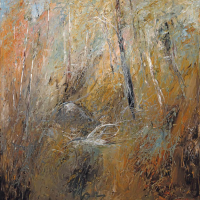46. ARTHUR BOYD Bushland

As one of the most significant Australian artists of the twentieth century, Arthur Boyd contributed hugely to the breadth, credibility and identity of Australian art. To comprehend his impact, let us acknowledge his description by author and art historian, Tom Rosenthal:
Of all the artists I have known and studied, his oeuvre is the most massive and varied, though still consistent, in the history of twentieth century painting an oeuvre incomparable in post-1945 art in its richness and vitality, in the sheer abundance of square metres, in all media, covered with glowing paint and imagery.1
Boyd was the most successful of a veritable creative dynasty beginning with his grandparents Emma Minnie aBeckett (1858-1936) and Arthur Merric Boyd (1862-1940), his uncle Penleigh (1890-1923) and his parents Merric (1888-1959) and Doris (1888-1960). Arthurs siblings, Lucy (19162009), Guy (1923-1988), David (1924-2011) and Mary (1926-2006) were all talented artists in their own right. Their family home, Open Country, in Murrumbeena was an intensely creative environment and is where Boyd began painting at just fourteen. He went on to be a pivotal member of illustrious modern art group, the Antipodeans, alongside Charles Blackman (1928-2018), John Brack (1920-1999), John Perceval (1923-2000), Robert Dickerson (1924-2015), Clifton Pugh (1924-1990) and his own brother David Boyd. Further accolades of his impressive career include representing Australia in the Venice Biennale in 1958, being appointed Companion of the Order of Australia in 1992, and being named Australian of the Year in 1995.
The landscape genre is one that Arthur Boyd repeatedly revisited throughout his life. Between his intensely imaginative bouts of figurative painting, such as his Nebuchadnezzar or Biblical subjects, Boyd returned to the tranquillity of landscape painting, almost as a palate cleanser. Many of his series, in particular his famed Bride series, have a distinctly ominous feel as Boyd employs dark tones and sombre subjects. In contrast, his landscapes often provide a point of respite, with warmer, lighter hues and more serene, optimistic subjects.
The present work is believed to have been painted in 1970, between his Nebuchadnezzar works of the late 1960s and his Shoalhaven works upon his return to Australia from London in 1971.2 Elements of each series are evident in Bushland; the frantic brushstrokes and semi-abstract backgrounds of his Nebuchadnezzar paintings, and the same subject matter as his Shoalhaven works, the Australian bush. Being a member of the Antipodeans, who advocated for figurative art in Australia, Boyd never employed complete abstraction in his practice. As we see here, what may at first glance present itself as a tangle of colour and movement, quickly orders itself as a bush scene; the changes in colour and depth perfectly imitating light falling through the untidy branches of gum trees.
Footnotes
- Rosenthal, T., in Hoff, U., The Art of Arthur Boyd, Andr Deutsch Limited, London, 1986, p.13
- McKenzie, J., Arthur Boyd: Art & Life, Thames & Hudson, London, 2000, p.214
Asta Cameron BA, MA (Art Curatorship)